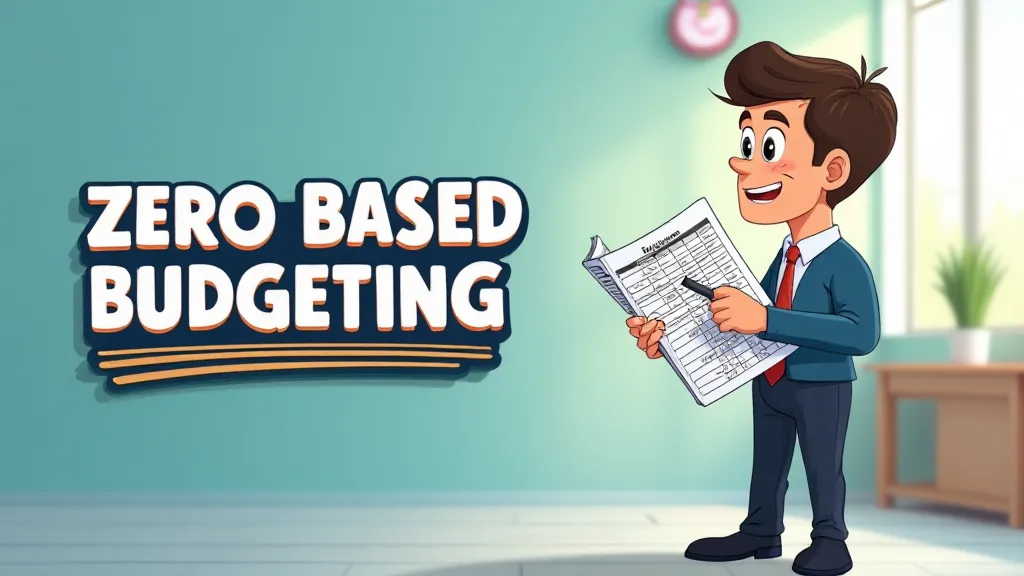
Hi friends! Ever feel like your money just vanishes into thin air by the end of the month? You’re not alone. Most of us just hope there’s enough left after paying the bills. But what if I told you there’s a simple, powerful way to tell every single rupee exactly where to go, ensuring you’re in complete control? That’s the magic of zero based budgeting. In this guide, we’re going to break down this life-changing method step-by-step. We’ll cover what it is, why it works so well, and exactly how you can start using it today to crush your financial goals in 2024. Get ready to transform your relationship with money!
What is Zero Based Budgeting? A Clear Zero Based Budgeting Definition
Understanding the Core Concept of Zero-Based Budgeting
At its heart, zero based budgeting is a method where your income minus your expenses equals zero. That’s the simple zero based budgeting definition. But don’t let the word “zero” scare you—it doesn’t mean you have zero money in the bank. It means you’re giving every dollar you earn a specific job to do, whether that’s for bills, savings, investments, or even fun money. When every rupee has a purpose, there’s no such thing as “leftover” cash that mysteriously disappears. This intentional approach is what sets it apart from simply tracking your spending after the fact. It’s a proactive plan for your money, created before the month even begins.
The Origin and Philosophy Behind the Zero-Based Budget
The concept was popularized by personal finance expert Dave Ramsey as a way for individuals and families to take back control. The philosophy is built on awareness and intentionality. Instead of looking at your bank balance and wondering what you can afford, you decide in advance based on your priorities. This method forces you to scrutinize every expense, asking, “Is this necessary?” and “Does this align with my goals?” It transforms budgeting from a passive, reactive chore into an active, empowering strategy. You become the CEO of your financial life, making deliberate decisions about your company’s (your household’s) resources.
Key Terminology and How the System Operates
To master the zero based budgeting system, you need to understand its language. Your “Income” is all the money you bring in during the month. Your “Expenses” are every single outflow, categorized into groups like Housing, Food, Transportation, and Savings. The goal is to “Assign” all of your income to these categories until the difference is zero. This often involves creating “Sinking Funds” for irregular expenses like car maintenance or annual insurance premiums, breaking them into manageable monthly savings goals. The system operates on a monthly cycle, requiring you to plan anew each month, which accounts for income and expense fluctuations, making it incredibly adaptive to real life.
How to Create a Zero Based Budget: Your Step-by-Step Zero Based Budgeting Method
Step 1: Calculate Your Total Monthly Income
The absolute first step in the zero based budgeting method is to know exactly how much money you have to work with. This means calculating your total monthly take-home pay—that’s the amount that actually hits your bank account after taxes and other deductions. If you’re salaried, this is relatively consistent. If your income is variable, like for freelancers or those on commission, you’ll need to make an educated estimate based on an average of the last few months. Include all reliable sources of income: your primary job, side hustles, rental income, or any other consistent cash flow. This number is the foundation of your entire budget; you can’t assign rupees you don’t know you have. This initial calculation is the non-negotiable starting point that dictates every financial decision you’ll make for the month.
Step 2: List and Categorize All Your Expenses
Next, you need to list every single expense you anticipate for the upcoming month. Start with your fixed, non-negotiable costs: rent or mortgage, utilities, loan payments, insurance premiums, and minimum debt payments. Then, move to variable expenses that are necessary but fluctuate, such as groceries, gasoline, and public transportation costs. Finally, account for discretionary spending like dining out, entertainment, and hobbies. Don’t forget the often-overlooked categories! This includes irregular expenses you save for monthly (like your annual LIC premium divided by 12) and, most importantly, your financial goals—savings, investments, and debt repayment beyond the minimum. The key is to be ruthlessly thorough; every potential outflow must be considered.

Step 3: Assign Your Income to Expenses Until You Reach Zero
This is where the magic happens. Using the total income figure from Step 1, you begin allocating funds to each expense category from Step 2. Start with your necessities—the Four Walls: food, utilities, shelter, and transportation. Once those are covered, fund your other obligations and priorities. You work your way down the list until your income minus your assigned expenses equals zero. If you have money left over after funding all your categories, that’s a signal to assign it to a goal, like building your emergency fund or accelerating your home loan payoff. Conversely, if you run out of money before you run out of categories, you must go back and make adjustments—cutting back on discretionary spending or finding ways to increase your income. This process of negotiation with yourself is the core of financial discipline.
Step 4: Track Your Spending and Adjust as You Go
Your budget is a living document, not a set-it-and-forget-it plan. The final, ongoing step is to track your transactions throughout the month. Every time you spend money, record it against the corresponding category in your zero based budgeting spreadsheet, notebook, or app. This real-time tracking shows you exactly how much you have left in each category before you spend. It prevents overspending and creates incredible awareness. Life is unpredictable, so adjustments are normal and expected. If you overspend in one category (e.g., groceries), you must “cover” that overspending by moving money from another category (e.g., entertainment) to bring it back to zero. This constant balancing act ensures you stay on track and your budget always reflects reality.
Zero Based Budgeting vs Traditional Budgeting: Which Method Wins for Your Wallet?
Fundamental Differences in Approach and Mindset
The battle of zero based budgeting vs traditional budgeting boils down to proactive vs. reactive planning. Traditional budgeting often involves looking at past spending patterns and projecting them forward, perhaps with a small increase for inflation. It’s backward-looking and can inadvertently justify past poor spending habits. Zero based budgeting, in stark contrast, starts from a “zero base” every single month. It does not assume previous spending was justified. Instead, it requires you to justify every expense anew, based on your current needs and goals for the upcoming month. This fundamental shift in mindset—from “what did I spend?” to “what should I spend?”—makes it a far more intentional and powerful tool for driving behavioral change and achieving financial goals.

Flexibility and Adaptability to Income Changes
This is where zero based budgeting truly shines, especially for those with variable incomes like freelancers, entrepreneurs, or commission-based employees. Traditional budgeting, based on historical averages, can be disastrous in a bad income month, leading to overspending. The zero-based method is inherently flexible. Each month, you sit down with whatever you actually earned the previous month (or a conservative estimate) and build your plan from scratch. In a great month, you can aggressively fund your savings, investments, and debt snowball. In a lean month, you can immediately scale back discretionary spending and focus solely on the essentials. This adaptability provides a realistic and stress-free framework for managing money, regardless of income volatility, making it a superior choice for the modern gig economy.
Impact on Savings and Debt Reduction Goals
When it comes to building wealth and eliminating debt, zero based budgeting is the undisputed champion. Traditional budgeting often treats savings as whatever is “left over,” which, as we know, is usually nothing. The zero-based method makes saving and debt repayment intentional, non-negotiable line items in your budget, just like your rent or electricity bill. You assign money to your “Emergency Fund” or “Credit Card Payment” category before you even think about assigning money to “Eating Out.” This prioritization ensures consistent progress toward your most important financial objectives. By forcing you to consciously allocate every rupee, it often reveals wasteful spending that can be redirected toward your goals, dramatically accelerating your journey to financial freedom compared to traditional methods.
The Life-Changing Zero Based Budgeting Benefits of Adopting This System
Unmatched Financial Awareness and Control
The most immediate and profound of all zero based budgeting benefits is the unparalleled level of awareness it creates. You are no longer guessing where your money went; you are directing it with purpose. This process eliminates financial fog and anxiety, replacing it with clarity and confidence. You know exactly how much you can spend on groceries this week, how much you’ve allocated for fun, and how much is moving you toward your dream vacation. This control is empowering. It transforms money from a source of stress into a tool for building the life you want. A 2022 Financial Health Network study showed that individuals who actively budget feel 40% more financially secure than those who don’t, and zero based budgeting is the most active form of budgeting there is.
Accelerated Progress on Debt and Savings Goals
As mentioned, this method is a rocket fuel for your financial goals. By making savings and debt repayment mandatory expenses, you ensure they happen every single month. This consistent action creates powerful momentum. For example, the average Indian household carries significant debt, with household debt to GDP sitting at over 40% according to the Reserve Bank of India. A zero based budgeting system is specifically designed to attack such debt efficiently. Every extra rupee uncovered from cutting unnecessary expenses can be thrown at your debt, creating a “snowball” or “avalanche” effect that pays it off years ahead of schedule. Similarly, your savings and investment accounts grow consistently, building compound wealth over time and providing a critical safety net.
Reduction of Financial Waste and Mindless Spending
Zero based budgeting acts like a magnifying glass on your spending habits, instantly highlighting waste. That daily latte, the unused streaming subscription, the impulse buys at the checkout counter—all of it becomes visible and accountable. When you have to consciously assign money to a “Coffee Shop” category, you start to evaluate whether the value is worth the cost. This dramatically reduces mindless spending. People often find hundreds, if not thousands, of rupees per month that were simply leaking out of their lives without providing any real joy or value. Plugging these leaks is how you find the money to fund your real priorities without needing a raise. It’s not about restriction; it’s about aligning your spending with your values.
Zero Based Budgeting for Beginners: Simple Tips and Common Pitfalls to Avoid
Starting Simple: Your First Month is a Practice Run
If you’re new to this, the most important tip for zero based budgeting for beginners is to be patient. Your first budget will not be perfect—and that’s okay! Treat it as a learning experience. Don’t try to create dozens of intricate categories right away. Start with broad categories: Income, Housing, Food, Transport, Utilities, Debt, Savings, and Fun. As you go through the month, you’ll notice where you need more detail. Maybe “Food” needs to be split into “Groceries” and “Dining Out.” The goal of the first month is simply to complete the cycle: plan, track, and adjust. The awareness you gain will be invaluable for creating a more accurate budget in month two. Remember, perfection is the enemy of progress; just starting is the biggest win.
Overcoming the “Feeling Restricted” Mindset
A common fear about zero based budgeting is that it will feel like a financial straitjacket, eliminating all spontaneity and fun. This is a pitfall you can easily avoid. The secret is to build fun *into* your budget! Create a discretionary category called “Blow Money” or “Fun Funds” for each family member. This is money that can be spent on anything, no questions asked. When you have guilt-free money to spend on whatever you want, the budget changes from a restrictive tool to a liberating one. It protects your fun money from being eaten by forgotten bills or impulse buys. You’re not being told you *can’t* spend; you’re being told you *can* spend, as long as it’s planned for. This shift is crucial for long-term adherence.
Tools and Tricks to Make Tracking Easier
Consistency is key, and making the tracking process as effortless as possible is vital for success. You don’t need fancy software to start. A simple notebook and pen can work perfectly. However, leveraging technology can automate much of the work. Use a dedicated zero based budgeting app like YNAB (You Need A Budget) or Goodbudget that is designed for this method. They automatically connect to your bank accounts (in read-only mode for security) and help you categorize transactions on the go. If you prefer spreadsheets, a simple zero based budgeting spreadsheet in Google Sheets or Excel is a powerful and free option. Set a daily 5-minute reminder to update your transactions. The easier you make the system, the more likely you are to stick with it.
Zero Based Budgeting Examples and Zero Based Budgeting Template to Kickstart Your Journey
Example 1: The Young Professional’s Budget
Let’s make this practical with some real-world zero based budgeting examples. Imagine a young professional in Bangalore with a monthly take-home pay of ₹75,000. Their zero based budgeting plan might look like this: Rent (₹20,000), Utilities (₹3,000), Groceries (₹7,000), Transport (Fuel/Auto) (₹5,000), EMIs (Car/Loan) (₹15,000), Insurance (LIC/Health) (₹3,000), Eating Out/Entertainment (₹5,000), Emergency Fund Savings (₹7,000), Investment (SIP) (₹5,000). Notice how every rupee is assigned: 75,000 – (20k+3k+7k+5k+15k+3k+5k+7k+5k) = 0. The categories for savings and investments are given the same weight as rent, ensuring they are never skipped. This is the blueprint for building wealth from an early stage.
Example 2: A Family’s Monthly Financial Plan
Now, consider a family with two children and a combined monthly income of ₹1,50,000. Their budget would include all the standard categories but also account for family-specific needs. Key categories might include: Housing (₹40,000), Groceries (₹15,000), School Fees & Activities (₹20,000), Children’s Miscellaneous (₹10,000), Domestic Help (₹8,000), Fuel & Car Maintenance (₹10,000), Utilities (₹6,000), Family Health Insurance (₹5,000), Family Entertainment (₹8,000), Vacation Fund (₹5,000), Debt Payments (₹10,000), Emergency Savings (₹8,000), Investments (₹5,000). Again, the math is checked to ensure it all adds up to zero. This plan ensures that future goals like vacations and current needs like school fees are all balanced responsibly.
Free Template and Spreadsheet to Get Started Today
You don’t need to start from scratch! We’ve provided a simple zero based budgeting template below that you can copy into a Google Sheet or Excel file. This basic framework includes common categories, but remember to customize it to your life. The “Budgeted” column is where you plan your month. The “Actual” column is where you track what you spend. The “Remaining” column will automatically calculate how much you have left in each category, turning red if you overspend. Using a pre-made zero based budgeting spreadsheet eliminates the setup hassle and lets you jump straight into the empowering part: taking control.
FAQs: zero based budgeting system Qs
Conclusion: Your Path to Financial Freedom Starts Now
Friends, zero based budgeting is more than just a method—it’s a mindset shift that puts you firmly in the driver’s seat of your financial life. It’s the difference between hoping you’ll have enough money and knowing exactly how you’ll use it to build the future you want. It requires honesty, effort, and consistency, but the rewards are truly life-changing: less stress, more control, accelerated goals, and ultimate financial freedom. You don’t need to be perfect. You just need to start. So, grab that notebook, open that spreadsheet, and give every single rupee a job to do. Your future self will thank you for it.
What’s your biggest challenge with budgeting? Share your thoughts in the comments below! And don’t forget to subscribe to our newsletter for more simple guides to mastering your money.




